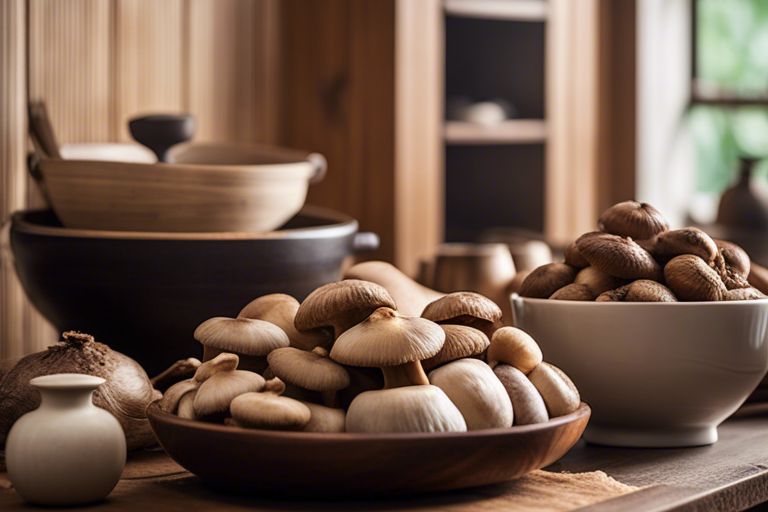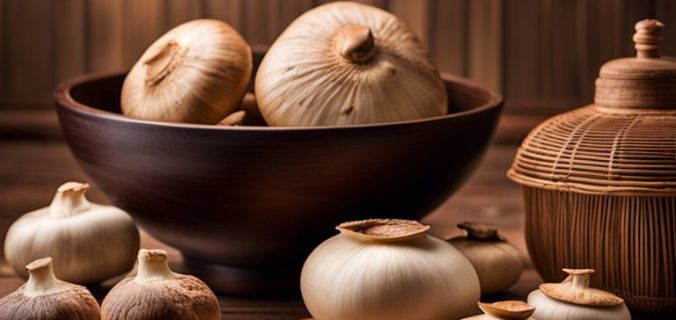You may have noticed the rich umami flavor and unique meaty texture that shitake mushrooms bring to Asian dishes, but do you know why they are such a staple in Asian cuisine? These mushrooms have been prized for their nutritional value and medicinal properties for centuries, playing a central role in traditional dishes and holistic medicine practices. Let’s explore the reasons behind the widespread popularity of shitake mushrooms in Asian cooking.
Key Takeaways:
- Umami Flavor: Shitake mushrooms are prized for their rich umami flavor, which adds depth and complexity to dishes.
- Nutritional Benefits: These mushrooms are a good source of vitamins, minerals, and antioxidants, making them a healthy choice in Asian cuisine.
- Versatile Ingredient: Shitake mushrooms can be used in a variety of dishes, from stir-fries to soups, making them a staple in Asian cooking.
History of Shitake Mushrooms in Asian Cuisine
Origins and Early Uses
Early records show that shitake mushrooms have been cultivated in Asia for over a thousand years, with origins tracing back to China. These savory and meaty fungi were highly prized by ancient emperors and nobility for their rich taste and believed medicinal properties.
Spread Throughout Asia
With the passage of time, the popularity of shitake mushrooms spread beyond China to other Asian countries such as Japan, Korea, and Vietnam. This versatile ingredient quickly became a staple in Asian cuisine, known for its unique umami flavor and nutritional benefits.
Plus, shitake mushrooms are not only delicious but also packed with antioxidants that help boost your immune system and reduce inflammation in the body. No wonder they have become a beloved ingredient in numerous Asian dishes!
Nutritional Benefits of Shitake Mushrooms
High in Antioxidants and Fiber
On Shiitake mushrooms, fresh or dried – Zest and Herbs, you’ll find that these flavorful fungi are not only delicious but also packed with nutritional goodness. Shitake mushrooms are rich in antioxidants such as selenium and vitamins A, C, and E. These antioxidants help combat oxidative stress in your body, reducing inflammation and lowering the risk of chronic diseases.
Additionally, shitake mushrooms are a great source of fiber, which is necessary for digestive health. Fiber aids in digestion, helps maintain a healthy gut microbiome, and can contribute to a lower risk of heart disease and diabetes. By including shitake mushrooms in your diet, you’re not only enjoying a tasty ingredient in your dishes but also boosting your overall health.
Rich in Vitamins and Minerals
On Shiitake mushrooms, fresh or dried – Zest and Herbs, you’ll also discover that shitake mushrooms are rich in vitamins and minerals necessary for your well-being. These mushrooms are a good source of B vitamins such as riboflavin, niacin, and pantothenic acid, which are crucial for energy production and cognitive function.
High in minerals like copper, zinc, and manganese, shitake mushrooms support immune function, nervous system health, and overall vitality. By incorporating these nutrient-dense mushrooms into your meals, you can ensure that you’re getting a dose of necessary vitamins and minerals to keep your body functioning at its best.
Potential Health Benefits
Any article on shitake mushrooms would be incomplete without mentioning their potential health benefits. These mushrooms have been linked to various positive health outcomes, including enhanced immune function, improved heart health, and potential anticancer properties. The beta-glucans found in shitake mushrooms have been shown to boost immune response, while their anti-inflammatory properties can help reduce the risk of cardiovascular diseases.
Health experts recommend incorporating shitake mushrooms into your diet regularly to reap these potential health benefits and to add a delicious umami flavor to your favorite dishes. By enjoying these nutritious mushrooms, you’re not only treating your taste buds but also nurturing your body from the inside out.
Culinary Uses of Shitake Mushrooms
Many Asian cuisines incorporate shitake mushrooms in a variety of dishes due to their rich, earthy flavor and meaty texture. These mushrooms add depth and umami to dishes, making them a staple ingredient in both traditional and modern cooking.
Soups and Stews
Stews: Shitake mushrooms are a popular addition to soups and stews in Asian cuisine. The mushrooms absorb the flavors of the broth, adding a unique depth to the dish. Whether you’re making a hearty miso soup or a rich pork stew, adding shitake mushrooms can take your dish to the next level.
Stir-Fries and Sautees
The: When considering stir-fries and sautées, shitake mushrooms are a versatile ingredient that pairs well with a variety of vegetables and proteins. Their intense flavor holds up well to high heat cooking methods, creating a delicious caramelization that adds complexity to your dishes.
Grilled and Roasted Dishes
Understanding: Grilled shitake mushrooms are a delightful addition to any barbecue or outdoor party. Simply marinate them in a mixture of soy sauce, garlic, and ginger before grilling for a smoky, savory treat. When roasted, shitake mushrooms develop a crispy exterior while maintaining a juicy interior, making them a delicious side dish for any meal.
Shiitake Mushrooms in Traditional Asian Medicine
Once again, shiitake mushrooms prove their versatility by not only being a staple in Asian cuisine but also playing a vital role in traditional Asian medicine. Let’s explore into the ways in which these mushrooms are incorporated into the rich tapestry of Eastern medicinal practices.
Chinese Medicine
Traditional Chinese Medicine has long revered shiitake mushrooms for their medicinal properties. In Chinese herbalism, shiitake mushrooms are believed to boost the immune system, support cardiovascular health, and improve vitality.
Japanese Kampo
Shiitake mushrooms are an vital component of Japanese Kampo, a traditional medicinal practice that blends Chinese medicine concepts with indigenous Japanese herbs. In Kampo, shiitake mushrooms are prized for their ability to enhance immune function and promote longevity.
Japanese herbalists often recommend shiitake mushrooms to combat fatigue and increase resilience in the face of illness.
Korean Hanuihak
An integral part of Korean traditional medicine, shiitake mushrooms are known for their anti-inflammatory and antioxidant properties. In Korean Hanuihak, these mushrooms are valued for their ability to balance the body’s energy and promote overall wellness.
A regular consumption of shiitake mushrooms in Korean Hanuihak is believed to aid digestion and improve circulation, contributing to a state of optimal health.
Cultivation and Harvesting of Shitake Mushrooms
Log Cultivation
Not only are shitake mushrooms revered for their rich umami flavor in Asian cuisine, but they are also highly prized for their unique cultivation methods. One traditional method of cultivating shitake mushrooms involves using logs as growing mediums. In this technique, freshly cut hardwood logs are inoculated with shitake spawn and left to incubate in a shady, humid environment.
Sawdust Spawn
Cultivation of shitake mushrooms can also be done using sawdust spawn. This method involves mixing sawdust with mycelium culture in a sterile environment to create a substrate for growing mushrooms.
Mushrooms grown using the sawdust spawn method tend to have a higher yield and faster growth compared to log cultivation. The sawdust provides a nutrient-rich medium for the mycelium to thrive, resulting in more robust mushroom growth.
Harvesting Techniques
Harvesting shitake mushrooms requires finesse to ensure a successful harvest. Carefully cutting the mushrooms at the base of the stem is important to allow for regrowth and future harvests. Additionally, using a gentle twisting motion when picking mushrooms helps prevent damage to the delicate fungus.
For instance, did you know that shitake mushrooms can be harvested multiple times throughout the growing season? By properly caring for your mushroom logs or sawdust spawn, you can enjoy multiple bountiful harvests of these prized fungi.

Shiitake Mushrooms in Modern Asian Cuisine
After becoming a staple in traditional Asian kitchens, shiitake mushrooms have found their way into modern Asian cuisine, adding depth and flavor to a variety of dishes.
Fusion Dishes
On your culinary explorations, you may come across fusion dishes that blend traditional Asian flavors with western cooking techniques, incorporating shiitake mushrooms in innovative ways. These dishes offer a unique twist on classic recipes, incorporating the umami-rich flavor of shiitakes into dishes like pasta, risotto, and tacos.
Innovative Preparations
Mushrooms are incredibly versatile, lending themselves to a wide range of innovative preparations in modern Asian cuisine. Chefs are using techniques like pickling, fermenting, and even dehydrating shiitake mushrooms to create new textures and flavors that elevate dishes to new heights.
To fully appreciate the versatility of shiitake mushrooms, you can try them prepared in various ways such as marinated, grilled, or even turned into crispy chips for added crunch and flavor in salads or as a garnish.
Shiitake-Based Products
To enhance the accessibility and convenience of using shiitake mushrooms in your cooking, you’ll find an array of shiitake-based products on the market. From shiitake mushroom powders and extracts to snacks like shiitake jerky, these products offer an easy way to incorporate the rich, earthy flavor of shiitakes into your meals.
An important point to note is that when purchasing shiitake-based products, ensure they are sourced from reputable suppliers to guarantee the quality and authenticity of the mushrooms used.
Conclusion
Summing up, shitake mushrooms have become a staple in Asian cuisine due to their rich umami flavor, meaty texture, and numerous health benefits. These versatile mushrooms can be used in a variety of dishes, from stir-fries to soups to steamed buns, adding depth and complexity to the flavors. Their popularity in Asian cooking can be attributed to their long history of use in traditional medicine and their cultural significance. Incorporating shitake mushrooms into your meals can not only enhance the taste but also provide a range of vital nutrients and potential health benefits.
Next time you’re thinking of trying a new Asian recipe, consider adding some shitake mushrooms to bring an authentic and delicious flavor to your dish. Whether you’re a seasoned cook or a beginner in the kitchen, these versatile mushrooms are sure to elevate your culinary experience and introduce you to the wonderful world of Asian cuisine.
FAQ
Q: What makes shitake mushrooms popular in Asian cuisine?
A: Shitake mushrooms are popular in Asian cuisine due to their rich, earthy flavor and meaty texture. They are versatile and can be used in various dishes, adding depth and umami flavor.
Q: How are shitake mushrooms typically used in Asian cooking?
A: Shitake mushrooms are commonly used in stir-fries, soups, stews, and noodle dishes in Asian cooking. They can also be dried and rehydrated to enhance their flavor in dishes.
Q: Are shitake mushrooms nutritious?
A: Yes, shitake mushrooms are nutritious and low in calories. They are a good source of vitamins, minerals, and antioxidants. Shitake mushrooms also contain compounds that may have immune-boosting and anti-inflammatory properties.

